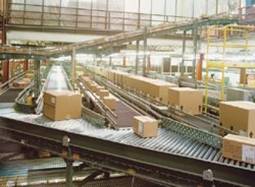|
Holste Says:
|
 Driven by demand for higher system throughput performance, system engineers have developed central merge control program logic that can eliminate most of the slug gap losses. Driven by demand for higher system throughput performance, system engineers have developed central merge control program logic that can eliminate most of the slug gap losses.
|
The central merge is the place in a distribution system where inbound conveyor lines, transporting product from various receiving, cross dock, picking, special processing areas, and sometimes product being re-circulated by the shipping sorter, are collected into one main takeaway conveyor line feeding the sorter. Accumulation lines feed metering belts, which control the staging and release of product. The number of inbound lines being served by the central merge can be as few as 3 or 4, to a half dozen or more. Each line automatically releases a slug of product, one line at a time.
 Up until a few years ago, the line release logic in common use resulted in large gaps between slugs. With this logic, the next line (in priority) cannot be released until the current line has completed its release. For example, let’s say there are 6 lines feeding the merge conveyor. Line #1 is closest to the output end of the merge conveyor and Line #6 is farthest away. Line #6 cannot begin its release until Line #1 has completed its release, plus a short time delay to allow the last case in the slug to clear the intersection. In this example, the distance between slugs could easily be 15 feet or more. Up until a few years ago, the line release logic in common use resulted in large gaps between slugs. With this logic, the next line (in priority) cannot be released until the current line has completed its release. For example, let’s say there are 6 lines feeding the merge conveyor. Line #1 is closest to the output end of the merge conveyor and Line #6 is farthest away. Line #6 cannot begin its release until Line #1 has completed its release, plus a short time delay to allow the last case in the slug to clear the intersection. In this example, the distance between slugs could easily be 15 feet or more.
Even when side-by-side lines are released, the gap will be 3 to 5 feet. The gaps between slugs may close up and disappear by the time the cases are inducted onto the sorter, but system throughput has suffered a loss that cannot be made up. Because the sequence of line release is driven by inbound volumes, the length of the accumulation lines, release sequence priorities, and several other factors which are constantly changing, the loss is hard to calculate without doing a simulation. Most system designers factor in 10 to 15% for central merge inefficiency.
Driven by demand for higher system throughput performance, system engineers have developed central merge control program logic that can eliminate most of the slug gap losses. The merge control program contains precise timing and tracking logic, which reflects the distance and travel time between lanes. This allows a downstream lane to continue releasing for some time after an upstream lane has started to release, so that gaps between slugs are minimized on the merge conveyor, and throughput is maximized. Applying this advanced logic to the above example; prior to the last case being released from Line #1, the first case from Line #6 will be released. As a result, the gap between slugs is reduced to just a few inches regardless of line release sequence. I have seen this merge control program logic in operation and it is fascinating to watch.
If your distribution system includes a central merge and you are looking for ways to increase system throughput, utilizing more efficient release logic may be worth considering.
Agree or disgree with our expert's perspective? What would you add? Let us know your thoughts for publication in the SCDigest newsletter Feedback section, and on the web site. Upon request, comments will be posted with the respondents name or company withheld.
|